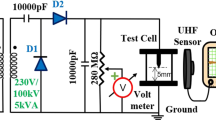Abstract
Performance and life of any transformer depend entirely on the dielectric property of the insulation used. In recent times, ester oil is replacing the mineral oil. In this paper, effects of electrical aging on ester oil in the presence of pressboard as a barrier between high voltage and ground electrode is studied. Corona inception voltage has been used to understand the variation in the electrical characteristics of the oil with time. Corona aging induces degradation of ester oil resulting in the formation of carbonaceous particles. This leads an increase in oil concentration occurring due to particles suspension of different size. To analyze this variation, dynamic light scattering analysis is carried out with the oil samples. It was observed that ester oil is fluorescent in nature and formation of carbonaceous particles on aging leads to change in its fluorescence characteristics. To monitor and characterize the degradation, a fluorescence-based analysis is used to obtain the fluorescence data as 3D excitation emission matrix.









Similar content being viewed by others
References
Adler HA, Cosgrove MF (1965) Simulated service aging tests of insulating oils in transformers. IEEE Trans Power Appar Syst 84(8):657–666
Balasubramanian M, Ravi G, Dharmalingam V (2012) Interdependence of thermal and electrical stresses on initiating degradation of transformer insulation performances. In: IEEE—international conference on advances in engineering, science and management (ICAESM-2), pp 399–402
Billig E (1946) Mechanical stresses in transformer windings. Electr Eng Part II Power Eng J Inst 93(33):227–243
Choe E, Min DB (2007) Chemistry of deep-fat frying oils. J Food Sci 72(5):R77–R86
Coulibaly ML, Perrier C, Marugan M, Beroual A (2013) Aging behavior of cellulosic materials in presence of mineral oil and ester liquids under various conditions. IEEE Trans Dielectr Electr Insul 20(6):1971–1976
Deepa S, Sarathi R, Mishra AK (2006) Synchronous fluorescence and excitation emission characteristics of transformer oil ageing. Talanta 70(4):811–817
Devins JC, Rzad SJ, Schwabe RJ (1981) Breakdown and prebreakdown phenomena in liquids. J Appl Phys 52(7):4531–4545
Ganger B, Maier G (1974) On electrical aging of oil-impregnated high-voltage dielectrics. IEEE Trans Electr Insul 9(3):92–97
IEC 60270 (2001) High Voltage Test Tehniques- Partial Discharge Measurement. 3rd edn. Reference number IEC 60270:2000(E), Commission Electrotechnique Internationale, Switzerland
Izeki N, Kurahashi A, Matsuura K (1971) Behavior of oil corona and damage of transformer insulation. IEEE Trans Power Appar Syst 90(5):2330–2338
Judd MD, Cleary GP, Bennoch CJ (2002) Applying UHF partial discharge detection to power transformers. IEEE Power Eng Rev 22(8):57–58
Kao S, Asanov AN, Oldham PB (1998) A comparison of fluorescence inner-filter effects for different cell configurations. Instrum Sci Technol 26(4):375–387
Lakowicz JR (2006) Principles of fluorescence spectroscopy. 3rd edn. Springer
Narasimha P, Chakrasali RL (2017) Distribution transformer failure in India root causes and remedies. In: International conference on innovative mechanisms for industry applications (ICIMIA), pp 106–110
Neffer AG, Rodrigo A, Hector C II, Vargas IH III (2011) J Braz Chem Soc 22(12) (São Paulo)
Oommen TV, Claiborne CC, Walsh EJ, Baker JP (2000) A new vegetable oil based transformer fluid: development and\nverification. In: 2000 annual report conference on electrical insulation and dielectric phenomena (Cat. No. 00CH37132), pp 308–312
Panigrahi SK, Thakur S, Sarathi R, Mishra AK (2017) Understanding the physico-chemical properties of thermally aged natural ester oil adopting fluorescent technique. IEEE Trans Dielect Electr Insul 24(6):3460–3470
Sarathi R, Sheema IPM, Rajan JR, Danikas MG (2014) Influence of harmonic AC voltage on surface discharge formation in transformer insulation. IEEE Trans Dielectr Electr Insul 21(5):2383–2393
Thakur S, Sarathi R, Gautam R, Vinu R (2017) Thermal aging of cellulosic pressboard material and its surface discharge and chemical characterization. Cellulose 24(11):5197–5210
Valeur B, Berberan-Santos MN (2012) Molecular fluorescence: principles and applications. 2nd edn. Wiley
Yadav KS, Sarathi R (2015) Influence of thermally aged barrier on corona discharge activity in transformer oil under AC voltages. IEEE Trans Dielectr Electr Insul 22(5):2415–2423
Ziomek W (2012) Transformer electrical insulation. IEEE Trans Dielectr Electr Insul 19(6):1841–1842
Author information
Authors and Affiliations
Corresponding author
Rights and permissions
About this article
Cite this article
Thakur, S., Prakash, S., Mishra, A.K. et al. Understanding the Impact of Corona Aging of Ester Oil Adopting Fluorescent Technique. INAE Lett 3, 251–256 (2018). https://doi.org/10.1007/s41403-018-0056-x
Received:
Accepted:
Published:
Issue Date:
DOI: https://doi.org/10.1007/s41403-018-0056-x




